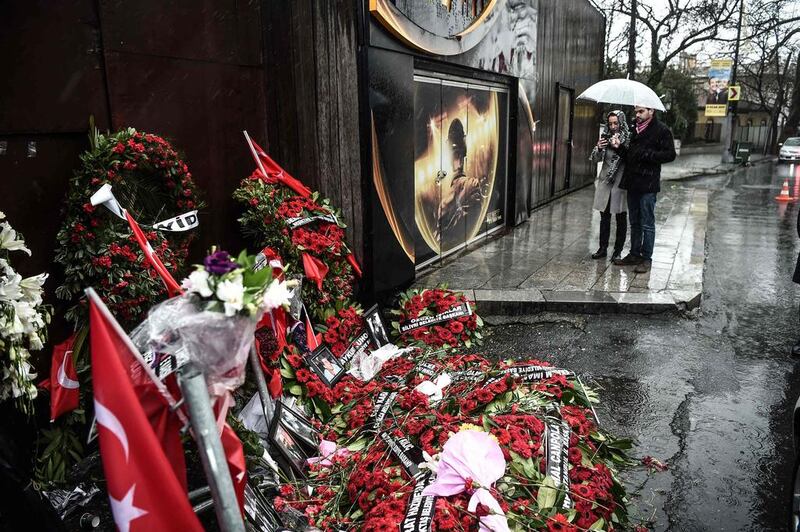ISTANBUL // The survivors huddled atop a giant industrial freezer in silence as the ISIL gunman entered the nightclub kitchen. Wiping his Kalashnikov free of fingerprints, he did not see them as he changed clothes and put on a Santa hat.
He had fired 180 rounds in seven minutes and killed 39 people. After smearing himself with their blood, he left the kitchen and blended into the crowd of survivors being taken out of the building.
There was a traffic jam when he arrived an hour earlier, so he walked the last few hundred metres to the Reina club, one of the most glamorous nightspots in Istanbul where the New Year’s Eve revelries were in full swing. His AK-47 concealed beneath his coat, he pulled the weapon out only when he was within easy range of the club’s unarmed guards.
Ali Unal, co-owner of the Reina, was smoking outside and talking on his mobile phone. It was 1.20am and Mr Unal thought the gunfire was New Year fireworks. Then bullets bounced off a heater in the entrance.
After killing a guard and a bystander, the attacker tossed a stun grenade and entered the club unhindered. An hour of terror followed, as the surveillance video and survivor accounts later showed.
Sprawling along the narrow strait that links Europe and Asia, the three-storey Reina had five restaurants and curtained terraces dropping down to the edge of the Bosphorus Strait. When the assailant entered, it was packed with about 600 people.
Starting from the upper terraces, he opened fire as he crossed blue-lighted dance floors pulsating with rave music. Some revellers fled to the seaside terraces and grabbed the long grey curtains to drop into the water below. Others sought hiding places. Many simply dropped to the ground as bodies fell over them, praying they would not be spotted.
“I caught a curtain,” said Karim Noureddine, a 27-year-old Lebanese who was at the club with his girlfriend. “I rappelled down and she followed me and I was able to escape. I did not know what was going on inside, because I was out in the first 50 seconds and running toward the sea.”
Sabri Ozturk, one of the club’s restaurant managers, had brought his wife and 19-year-old son to keep him company for New Year. He dropped to the floor and shouted to them to do the same.
“The gunfire wouldn’t cease,” he said. “They say seven minutes, but it felt like seven hours. Our feet and heads were on top of each other. My wife was under my arm. My hand was on my son’s head because he was protesting. I’m closing his mouth, telling him to be silent.”
They stayed that way for about an hour. “Then the noise stopped, but is the terrorist inside? Is he going to detonate a bomb? You start thinking: He should just blow it up so it can be over. That’s the state you are in,” Mr Ozturk said.
Yunus Turk, a 25-year-old Frenchman at the Reina with his cousin, was hiding on the terrace as the gunman moved through the club. He grabbed a table and held it in front of him as a shield, as bullets pinged off the metal. Yusuf Kodat, 23, another clubber, said, “I was just trying to calm the people around me, so the shooters wouldn’t notice us. Because I thought at the time that there had to more than one. I would never have imagined that one person could do so much.”
Security experts said the methodical attack was carried out by an experienced killer who emptied four machine gun cartridges in rapid succession, with magazines tied to each other for quicker action.
“I’m not just talking about a training camp, I’m talking he fought,” said security analyst Michael Horowitz.
Photos taken inside the club show most people were shot with deadly precision in the upper torso and some at point blank range on the floor.
“I was shot when I was already on the ground. He was shooting people that he had already shot,” said William Raak, an American who was wounded.
Alaa Abd El Hai, a 30-year-old Arab Israeli dentist who had come to the club with three friends, was on the dance floor when the gunman opened fire. The music stopped.
Sensing the shooter nearby, she crawled 15 metres to the kitchen with several others, searching for a hiding place. They tried a storage room but it was locked. Then they saw the freezer. The space above could hold them all, but was too high for some to reach. The men climbed up first, then reached down for the women. Ms El Hai is not sure how many crammed into the small space but she recalls there were two Germans, two Iranians, two Turks and an Egyptian woman. Four rounds later, the gunman ran out of ammunition. Peering through a curtain, the Egyptian woman saw him enter the kitchen with the weapon pointed at a woman’s head.
He spent 30 minutes wiping the AK-47 free of fingerprints then left it there, along with his coat. He changed clothes, put on a Santa hat and blended into the panicked crowd – smearing himself with blood on his chest, and limping.
Ms El Hai later learnt that her friend, 18-year-old Layan Nasser, was among the dead.
When police stormed the building 40 minutes after the massacre began, they made everyone put their hands up. When the club was finally emptied at around 2.30am, the shooter was among them. He hopped into a taxi unnoticed and remains at large.
According to government-linked Turkish media, the taxi driver said the man spoke on his mobile phone in Turkish and had no money for the fare. Later, back in the club kitchen, investigators found 500 Turkish lira in his coat pocket.
* Associated Press





